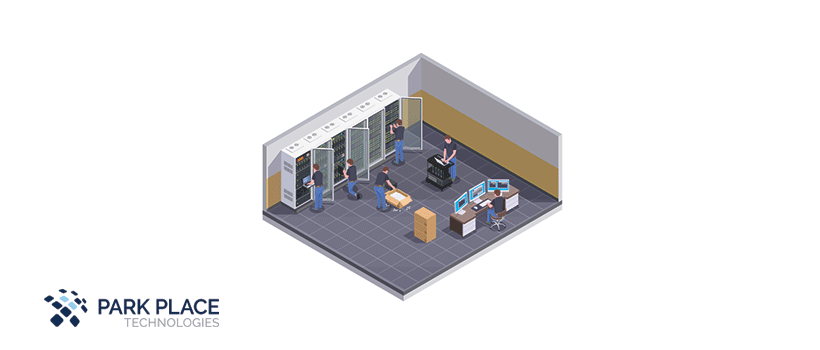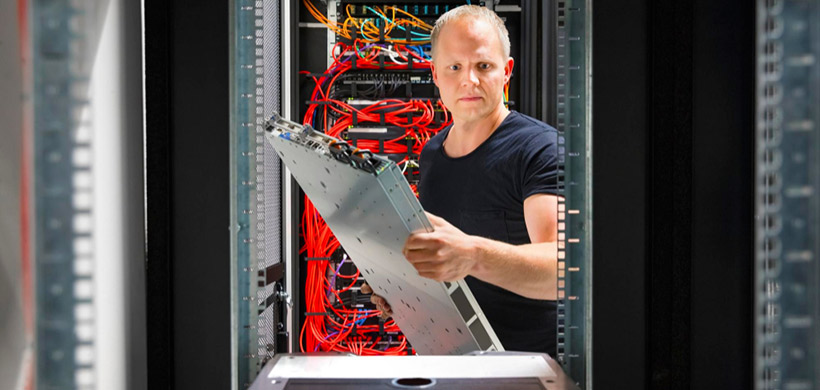Your Guide to the Data Center Decommissioning Process
Park Place Hardware Maintenance
Jump-to Section
Data Center Decommissioning Reasons and Use Cases
7-Step Data Center Shutdown Checklist
1. Create your Data Center Decommissioning Scope
2. Asset Discovery and Inventory
So, you’ve taken the decision to close or relocate your data center. Unlike moving to a new home, it’s not as simple as boxing up your belongings, switching off the lights and locking the front door. Secure decommissioning comes with months of meticulous planning to make sure the process goes smoothly.
Wherever you have chosen to host your data, the potential for disrupting business is far greater when you shut down a data center rather than when you open one in the first place. Why? Because, your critical data and business processes can live-on, housed on old devices that have been repurposed elsewhere.
Data Center Decommissioning Reasons and Use Cases
Ending the life of a data center isn’t a decision that you or your organization should take lightly. Many months of deliberation will have led to the decision of making one (or more) of your data centers redundant.

Today’s Data Center Managers have countless options for implementing hybrid IT infrastructure such as the cloud, colocation facilities, or merging data centers into a more manageable footprint.
Of course, the public cloud was the game changer. Using other companies’ secure and highly accessible data processing facilities allowed operators to decrease overhead and resources while increasing agility and digital capabilities at the same time.
Many DCMs have opted for a hybrid, part on-prem strategy. For example, they’ve moved specific intensive workloads such as archiving to the cloud, leading to redundancy of dedicated disaster recovery data centers.
As workloads have successfully transferred to the cloud, hundreds of thousands of companies stand as proof that decommissioning a large central data center can be a sensible option. Decommissioning of legacy data centers could continue course as we increasingly process data through fast, ‘edge’ mini data centers that bring local computing power closer to end users.
7-Step Data Center Shutdown Checklist
Making sure that your data center shutdown occurs with minimal disruption needs scrutiny and adherence to a data center decommissioning process.
One of the most straightforward ways to decouple risk is by following a pre-defined data center closure checklist that will give security for all your sensitive data stored on devices while achieving maximum resale value from decommissioning IT equipment. We’ve complied 7 of the most pressing considerations to work into your environment.
1. Create your Data Center Decommissioning Scope
Every plan starts with effective scoping. Within the scope, you will need to detail a timetable (that includes an optimal date based on likely business impact and available resources); a budget to decommission (that includes any potential resale values) alongside a full scope of work that considers processes, safety procedures, responsibilities and disposition.
Scoping starts with inventories. You must know what’s in the data center before you can take steps to decommission any part.
2. Asset Discovery and Inventory
You can approach asset discovery manually, physically capturing on-site detailed inventory, location, type of asset, software loaded.
Alternatively, you can use an ITAD partner’s automated discovery service that captures, discovers, updates, and details the entire global estate, isolating locations in mind for decommissioning. One of the reasons that automated network asset discovery may be preferable is that it discovers and details dependencies prior to shut down. You can assess the impacts of shutting down a particular asset.
Starting a decommission without a detailed list of assets, locations and serial numbers is unthinkable. Having this information captured at the beginning can ensure all IT assets and data center equipment are accounted for at the end, which is important for financial and legal recordkeeping.
3. Decommissioning Planning
Once equipped with a real-time view of your devices, you can dive into the detailed planning required for decommissioning a data center. At this step of your decommissioning project, you should find a specialized partner who can lead you through the logistical jungle of safe data migration and asset disposal. A good partner will also help you maximize your IT asset value recovery by finding the best resale prices available.
Accurate documentation cannot be stressed enough to prove data erasure, destruction, and certificates of destruction/disposal.
For a full hardware decommission in a standalone data center, take the following steps:
- Start with a full IT hardware asset discovery
- Work out a logical order for physical removal with minimal impact, that includes racked servers, disks, network gear, routers, servers, network, routers, tape libraries
- Decommission the software – SANs, firewalls, VMs etc.
- Remove ancillary equipment – Docking stations, UPS, keyboards, racks, rails kits, power cords, cables and cabinets
- Decommission the servers themselves
- Remove cabling
- Reconcile the inventory count of equipment, and document any discrepancies against the original asset list
- Ensure data destruction is watertight with linked reporting
- Box, pack, and ship equipment
- Move equipment to an assured facility in locked and sealed trucks where assets are prepared for resale or recycling
- Redeploy IT assets and server racks where possible
- Return any end-of-lease equipment and stop the contracts as soon as possible
- Documentation, documentation, documentation!
4. Logistics Materials Acquisition
It may seem like a no-brainer, but physical data center hardware can be especially heavy. Transportation of assets for both recycling and destruction will require materials like pallets, boxes, padding, packing foam, and the like. In addition, you’ll need heavy machinery like forklifts and pallet jacks to transport palletized hardware.
To ensure a secure chain of custody, it’s important that the moving trucks are locked and sealed to protect the hardware from theft (and the elements, if they are being recycled).
Coordinate all these materials and machines beforehand, as supply chain issues can have a major impact on your decommissioning timeline.
5. Backup and ITAD
The next step is to take a comprehensive backup and double check it’s surety. By now, you will have engaged with a reputable provider of ITAD services. Your provider should also double check your backups. In fact, many ITAD companies offer data center relocation which typically include supporting data and storage migration services. There’s a strong chance your decommissioning partner can take the weight of your data off your shoulders throughout the process.
Once backup data is verified as safe, decommissioning can start in earnest following your own plan that includes software, hardware, ancillary devices, racking and cabling.
Whether or not your device has a resale value is driven by a cost analysis on the age and state of the asset to identify which should be simply disposed of and their likely resale value. Specialist partners with expertise in the reusable market will have a strong grasp of market values in different regions together with the logistics on how and where they can sell equipment for optimal returns.
When it comes to the materials to be acquired in a decommission, your partner will also consider the value of components for sparing.

6. Pack and Move
With everything powered down and physically moved out of the data center, you can move to the final physical stage of decommissioning – disposition. Disposition involves packing, moving, palleting and terminating redundant contracts as soon as possible. Your ITAD partner will do the heavy lifting during this stage, but they will likely need you to sign off on security releases as shipments of legacy equipment leave your facility.
7. Equipment and Accounting Follow Up
Before any asset – even those that are destroyed on site – leaves the confines of the building, last verification checks should take place against the inventory, and again documentation should be accurately updated. This information should then be fed into the accounting and finance teams to ensure that they have accrued the correct write-offs for annual accounting.
Important items include the final resale price of hardware (if resold), that all hardware maintenance contracts have been cancelled, and that certificates of erasure or destruction have been processed.
You can begin to appreciate now how the enhanced documentation process also ensures that you have met and captured your environmental and regulatory responsibilities.
Get Professional Help with your Network and Hardware Decommissioning
Going back to the residential moving analogy at the start of the blog, just as you would never move houses without a specialist moving partner, it’s best not to attempt a data center decommission without having a trusted ITAD partner by your side.
Park Place Technologies offers data center professional services that can facilitate your data center decommissioning from start to finish. We provide a secure chain of custody, and because we’re a consumer of used hardware ourselves, we make it easier to reclaim the value of your old IT assets.
Contact our team for a quote today before you even start penciling a high-level checklist!



